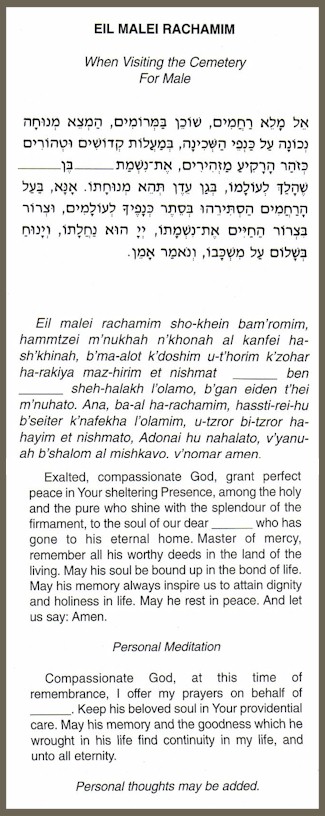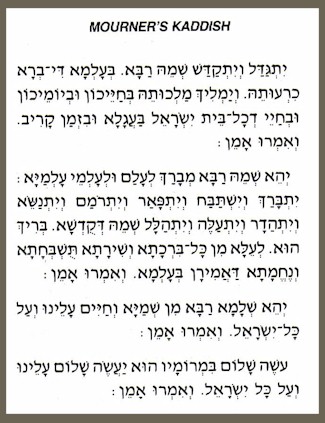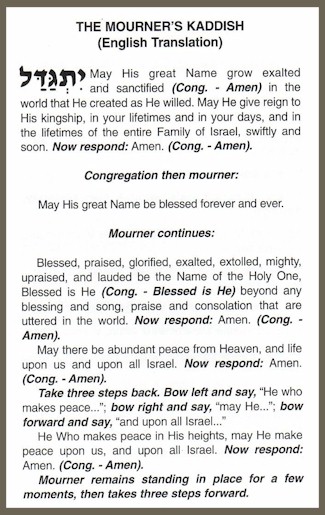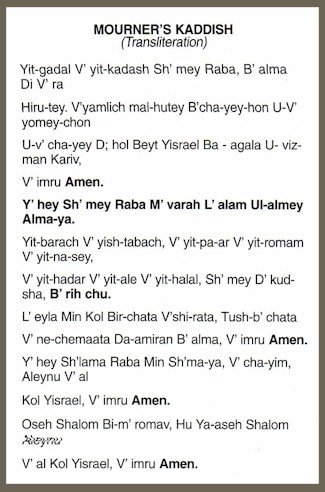Traditional Background | Psychological Function | Unveiling Service
TRADITIONAL BACKGROUND OF THE UNVEILING
The custom of placing a monument over the grave of a departed person is a very ancient Jewish tradition. The Book of Genesis, for example, records that Jacob erected a tombstone over the grave of his wife Rachel. From Biblical times onward, wherever Jewish communities have existed, Jews have continued this practice of erecting a memorial in honor of their deceased.
The tombstone is erected to indicate clearly where a person is buried, so that family and friends may visit the gravesite. It is also a way of remembering and honoring the memory of the person who has died.
Today, we refer to the ceremony of formally consecrating a tombstone as an "unveiling". While this ceremony has no origin in pre-modern Jewish life, this has become an acceptable practice today.
An unveiling takes place during the first year after death. There are no strict guidelines for the timing of an unveiling, and, while families may choose a date at any time after the end of the Shiva, it has become a contemporary practice to schedule this ceremony for some time between the end of Shloshim, the thirty day period of intensive mourning, and the first Yahrzeit, the anniversary of a death.
The unveiling is a mourning ritual which serves a very specific function in the healing process of the bereaved. It is not simply a perfunctory ritual, but rather, like the funeral, Shiva, Shloshim and Kaddish, the unveiling provides mourners with the opportunity for emotional and psychological healing.
The physical act of erecting and unveiling a monument allows for the expression of the sad and painful emotions of grief. Family members gather together, often from cities which are miles apart, and continue their mourning as a family, lending each other comfort and support in dealing with their grief.
For individuals who were not able to attend the funeral or Shiva, the unveiling ritual provides yet another opportunity to grieve and to acknowledge one's loss. Although painful, this realistic experience of grief can, over time, be very healing for mourners.
During the unveiling of a monument, as one sees the name of a beloved family member etched in stone, there is a stark realization of the finality of death. The impact can be quite jarring to some, and yet, at the same time, can provide a further opportunity to accept the reality of the loss. Thus, the unveiling ritual allows mourners to face death and loss realistically, and to affirm a commitment to life and to living.
The unveiling also allows the bereaved family members to honor and to recall the memory of their departed. It is a chance to continue to reflect upon the significance of that person's life, his or her accomplishments, and the people who were important. In a sense, through the unveiling, the memory of a person's life is etched permanently into the collective memory of the Jewish community.





The service for the unveiling of a monument is a short and simple one. It consists of the recitation of several Psalms; the actual removal of the veil from the memorial; the recitation of the malei rachamiim (the Memorial Prayer) and the Kaddish. A Minyan is required for the recitation of Kaddish; however, if there is no Minyan available, the Kaddish is omitted.
At the unveiling it is certainly appropriate for a family member to choose to speak about the person who has died, or to read a supplemental poem or prayer. It is best to discuss this with the officiating rabbi beforehand.
The following wording may be used ...
A thousand Years, in the sight of our eternal and merciful Father, are but a day; the years of our life but a passing hour. He grants us life and life He has taken away; praised be His name.
________has taken from our midst. We are pained by the gap in our lives. Yet love is strong as death; the bonds love creates are eternal. And ours is the blessing of memory, through which the lives of our departed continue to be with us
(The Covering Is Removed)
In the name of the family of _________and in the presence of his (her) family (and friends) we consecrate this monument to his (her) memory, as a token of our love and respect.
May his (her) soul be bound up in the bond of life.
Amen
The memorial prayer, Eil Malei Rachamim, is now recited.
If a minyan is present, the Mourner's Kaddish is recited.
Click Here For Audible Mourner's Kaddish
Please feel free to click the link below to view many other additional Prayers and Psalms
Additional Prayers and Psalms - Click Here


